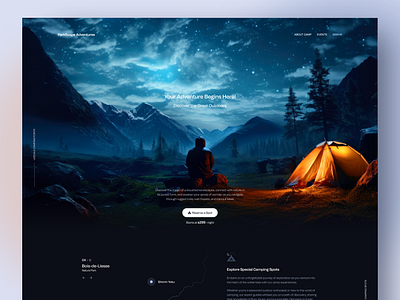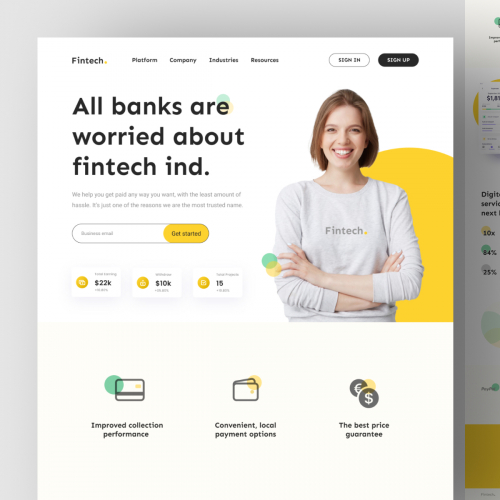How to Choose the Right Website Design for Your Business or Personal Brand
Modern Internet Site Design That Records Attention and Transforms
In a progressively digital landscape, contemporary website layout has emerged as a crucial variable in catching individual interest and driving conversions. As we discover these vital parts, it ends up being clear that recognizing their interaction can considerably influence a site's efficiency and customer satisfaction.
Significance of Visual Pecking Order
Aesthetic pecking order is an essential aspect in web site design, as it guides customers' interest and boosts their general experience. By tactically arranging web content, designers can direct customers to one of the most crucial details first, consequently boosting engagement and improving usability. Reliable visual power structure uses different methods, consisting of dimension, spacing, contrast, and color. Larger elements normally draw the eye, while contrasting colors can emphasize essential messages, making them stand apart amongst even more subdued elements.
Incorporating a sensible circulation in material setup is vital; as an example, putting one of the most critical info at the top of a page fosters instant recognition. Regular use of typography, such as varying font sizes and styles, helps establish a clear content structure. This company not only aids in navigating but also builds count on, as users really feel more comfy when they can easily find what they are trying to find.
Eventually, a well-executed visual hierarchy not only enhances aesthetic charm however likewise substantially impacts customer actions. By prioritizing necessary components and ensuring a seamless experience, designers can successfully transform site visitors right into clients, enhancing the significance of this fundamental style principle in modern site advancement.
Responsive Layout for All Instruments
Producing a seamless experience across numerous gadgets is essential in today's electronic landscape, where users accessibility websites from tablet computers, smartphones, and desktops alike. Receptive layout is a critical strategy that guarantees internet sites adjust fluidly to different display sizes, resolutions, and alignments. By using flexible grids, images, and CSS media inquiries, developers can produce layouts that preserve visual honesty and performance, despite the gadget being used.
The importance of receptive design prolongs past aesthetics; it directly influences customer involvement and conversion rates. A web site that works well on all tools urges longer sees and minimizes bounce prices, as users are much more likely to connect with content that is simple to browse. Search engines, particularly Google, focus on mobile-friendly sites in their rankings, making receptive layout a vital component of search engine optimization (SEO)
Including responsive layout not only improves user experience yet also streamlines the growth procedure. By producing a solitary website that works across devices, services can conserve time and sources compared to developing separate mobile and desktop computer variations. Inevitably, responsive design is an essential approach for modern-day site layout, making sure accessibility and fulfillment for all users, regardless of their tool.
Engaging Interactive Components
While a receptive layout lays the groundwork for a practical internet site, incorporating engaging interactive elements is crucial for catching user focus and promoting deeper connections. Website Design. Interactive components, such as computer animations, tests, and clickable infographics, produce a much more vibrant individual experience, encouraging site visitors to invest even more time on the website
Integrating interactive features can also guide users via facility info, making it simpler to digest content. For example, interactive sliders can highlight item variants, while ingrained videos can supply demonstrations or endorsements that reverberate more than fixed photos or message. Gamification strategies, like incentives for engaging or completing tasks with content, can enhance user motivation and retention.
Effective use of interactive elements not only improves the user experience yet can also lead to greater conversion prices. It is crucial to stabilize interactivity with performance; overly complex features might hinder website speed, adversely influencing customer contentment.
Structured Navigation Practices
Effective navigation is a keystone of any kind of successful internet site, as it directly influences user experience and content availability. Structured navigation techniques make certain that customers can quickly locate info, improving their communication with the website. A well-structured navigating food selection ought to be instinctive and simple, typically featuring a limited variety of key categories to prevent frustrating visitors.
To attain streamlined navigating, designers ought to prioritize an ordered structure that realistically organizes material. Carrying out breadcrumb tracks can offer users with context regarding their current place within the website, permitting for seamless backtracking. Furthermore, making use of drop-down food selections can efficiently preserve space while still offering access to subcategories.
Responsive layout is important, as navigation ought to be practical throughout all devices (Website Design). Mobile individuals, specifically, advantage from touch-friendly menus and collapsible sections that maintain functionality without jeopardizing aesthetic appeals

Efficient Call-to-Action Approaches
A well-crafted call-to-action (CTA) is vital for leading users towards wanted outcomes on a website, as it straight from the source motivates them to involve with content or buy. To optimize their efficiency, CTAs need to be clear, compelling, and purposefully positioned throughout the website.
First, make use of action-oriented language that communicates seriousness or value, such as "Get going," "Sign up with Now," or "Case Your Discount rate." This language not just inspires individuals however also sets clear expectations concerning the next steps.
2nd, think about style elements; CTAs must attract attention aesthetically through contrasting shades, sufficient whitespace, and prominent positioning. A switch that is very easy to see and click increases the probability of customer communication.
In addition, personalizing CTAs based on user behavior or demographics can dramatically boost engagement. Customized messages reverberate more with individuals, driving higher conversion prices.

Conclusion
These components collectively enhance user experience, guaranteeing that visitors stay engaged and motivated to discover material additionally. By prioritizing these style principles, services can dramatically improve user retention and conversion rates, eventually leading to greater success in the electronic landscape.
In a significantly digital landscape, contemporary web site layout this article has actually arised as a pivotal factor in recording customer attention and driving conversions.Visual hierarchy is an essential component in web site style, as it guides customers' interest and enhances their overall experience.The significance of receptive style prolongs beyond looks; it directly impacts customer involvement and conversion prices.Including receptive layout not just enhances user experience however additionally enhances the growth procedure. Ultimately, responsive style is a basic approach for modern-day web site layout, ensuring availability and satisfaction for all individuals, helpful site regardless of their device.